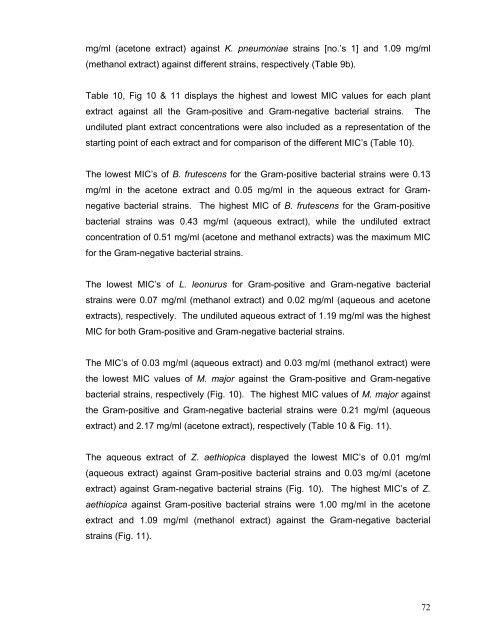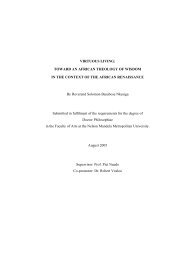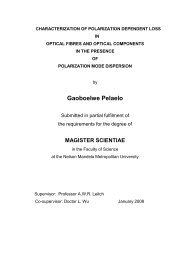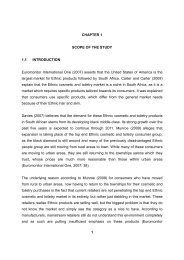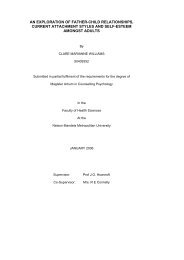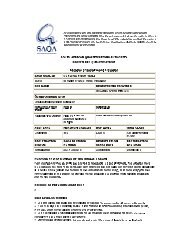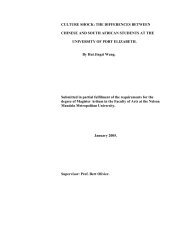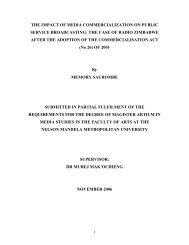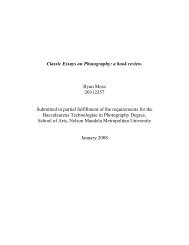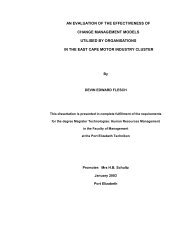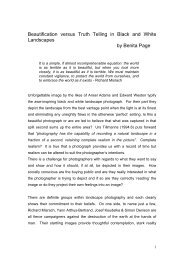an investigation into the antibacterial activities of medicinal plants ...
an investigation into the antibacterial activities of medicinal plants ...
an investigation into the antibacterial activities of medicinal plants ...
You also want an ePaper? Increase the reach of your titles
YUMPU automatically turns print PDFs into web optimized ePapers that Google loves.
mg/ml (acetone extract) against K. pneumoniae strains [no.’s 1] <strong>an</strong>d 1.09 mg/ml<br />
(meth<strong>an</strong>ol extract) against different strains, respectively (Table 9b).<br />
Table 10, Fig 10 & 11 displays <strong>the</strong> highest <strong>an</strong>d lowest MIC values for each pl<strong>an</strong>t<br />
extract against all <strong>the</strong> Gram-positive <strong>an</strong>d Gram-negative bacterial strains. The<br />
undiluted pl<strong>an</strong>t extract concentrations were also included as a representation <strong>of</strong> <strong>the</strong><br />
starting point <strong>of</strong> each extract <strong>an</strong>d for comparison <strong>of</strong> <strong>the</strong> different MIC’s (Table 10).<br />
The lowest MIC’s <strong>of</strong> B. frutescens for <strong>the</strong> Gram-positive bacterial strains were 0.13<br />
mg/ml in <strong>the</strong> acetone extract <strong>an</strong>d 0.05 mg/ml in <strong>the</strong> aqueous extract for Gramnegative<br />
bacterial strains. The highest MIC <strong>of</strong> B. frutescens for <strong>the</strong> Gram-positive<br />
bacterial strains was 0.43 mg/ml (aqueous extract), while <strong>the</strong> undiluted extract<br />
concentration <strong>of</strong> 0.51 mg/ml (acetone <strong>an</strong>d meth<strong>an</strong>ol extracts) was <strong>the</strong> maximum MIC<br />
for <strong>the</strong> Gram-negative bacterial strains.<br />
The lowest MIC’s <strong>of</strong> L. leonurus for Gram-positive <strong>an</strong>d Gram-negative bacterial<br />
strains were 0.07 mg/ml (meth<strong>an</strong>ol extract) <strong>an</strong>d 0.02 mg/ml (aqueous <strong>an</strong>d acetone<br />
extracts), respectively. The undiluted aqueous extract <strong>of</strong> 1.19 mg/ml was <strong>the</strong> highest<br />
MIC for both Gram-positive <strong>an</strong>d Gram-negative bacterial strains.<br />
The MIC’s <strong>of</strong> 0.03 mg/ml (aqueous extract) <strong>an</strong>d 0.03 mg/ml (meth<strong>an</strong>ol extract) were<br />
<strong>the</strong> lowest MIC values <strong>of</strong> M. major against <strong>the</strong> Gram-positive <strong>an</strong>d Gram-negative<br />
bacterial strains, respectively (Fig. 10). The highest MIC values <strong>of</strong> M. major against<br />
<strong>the</strong> Gram-positive <strong>an</strong>d Gram-negative bacterial strains were 0.21 mg/ml (aqueous<br />
extract) <strong>an</strong>d 2.17 mg/ml (acetone extract), respectively (Table 10 & Fig. 11).<br />
The aqueous extract <strong>of</strong> Z. aethiopica displayed <strong>the</strong> lowest MIC’s <strong>of</strong> 0.01 mg/ml<br />
(aqueous extract) against Gram-positive bacterial strains <strong>an</strong>d 0.03 mg/ml (acetone<br />
extract) against Gram-negative bacterial strains (Fig. 10). The highest MIC’s <strong>of</strong> Z.<br />
aethiopica against Gram-positive bacterial strains were 1.00 mg/ml in <strong>the</strong> acetone<br />
extract <strong>an</strong>d 1.09 mg/ml (meth<strong>an</strong>ol extract) against <strong>the</strong> Gram-negative bacterial<br />
strains (Fig. 11).<br />
72


